► All-electric 2020 supermini shoot-out
► New Honda E vs Pug e-208 vs Mini EV
► Which tiny plug-in gets the nod?
The first wave of Tesla-inspired EVs were big-money SUVs. Now the electric hatches are here: Honda’s E takes on the Mini Electric and Peugeot’s e-208.
Read on for CAR magazine's full Giant Test, photographed by Alex Tapley. And don't forget to check out our highly charged Electric car section for more advice and guides to life with electric vehicles (EVs).
The best electric cars and EVs
The cheapest EVs on sale today
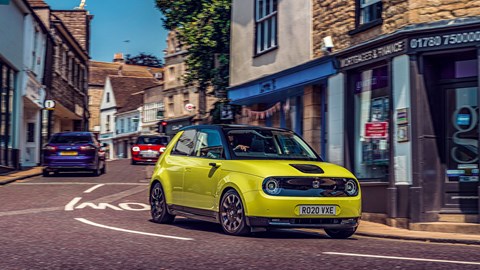
Honda E pre-flight briefing: why is it here?
The E is the first production EV from Honda, a company that was way ahead of the hybrid curve but has thus far dithered on EVs.
Any clever stuff?
You bet. The only rear-drive car here, the E is based on a new platform that will sire additional Honda EVs. While the E’s wheel-at-each-corner stance remains true to the concept car that previewed it, the details are a little blander. It has one of the most digitised dashboards ever seen on a small car – with screens stretching from door to door, bookended by sharp rear-view cameras designed to halve the size of over-the-shoulder blind spots.
Which version is this?
Only two versions are available in the UK: the base model at £26,660 and this top-rung Advance, which costs £2.5k extra in return for a brawnier 152bhp motor (versus the standard car’s 134bhp) plus upgraded heated seats/wheel, a digital rear-view mirror and the ability to spot parking spaces.
Our full Honda E review

Honda E road test
Ever wonder how the greatest game-changers make it to showrooms unsullied by committee or compromise? The thrill of a clean-sheet design and an over-achieving mission statement must spur on the cleverest engineers to make groundbreaking cars such as 1959’s Mini, the 1974 VW Golf and the first-generation Ford Focus or Audi TT (both 1998). Can the Honda E hope to join this exclusive club? At first glance, its daring wardrobe, electro smarts and digital talents certainly secure the interview.
And so it proves when introductions are made. It’s a shame some of the stance and conceptual slam-dunk of the Urban EV show car that sired the E were lost in the transition to showroom spec, but this is still one of Honda’s boldest designs for years. It’s dripping with cute detailing like the glass bonnet charging flap: it could convincingly wear the Apple apple. The question is: does it have the talent to match the bravura of its exterior design? If so it’ll be ready to sate the public’s swelling interest in EVs.
The Honda looks petite but it’s actually 45mm longer than the Mini Electric and comfortably the tallest of this trio. Cartoonishly styled and futuristic, it turns heads like no other small car. We find camera pods instead of door mirrors, an NFC (Near Field Communication) smartphone reader on the B-pillar (so you can use your phone to unlock the car) and full LED circular lights front and rear. This car’s tech credentials are front and centre, a point rammed home when you unlock the door and sink into the wool-effect front seats to face the iMax of widescreens. Put it this way: my teenage son was in touchscreen heaven when faced with the full-width digital displays that stretch from door to door, replacing everything from traditional dials to sat-nav and radio comms. If you’re the sort of person who’s driven mad by everything being app-controlled from your smartphone these days, you’re not going to like this interior.
But we do. It all works as intended, and we’ll forgive Honda’s Aquarium button on the homescreen, turning the twin 12-inch screens into a soothing goldfish bowl when parked up. The woke generation lap up this stuff. The screens’ matt surface hides grubby fingerprints well and the logic of the operating system is first-rate – it knocks spots off the Peugeot’s laggy menus and user experience. Something must have leaked into the water at HQ, as Hondas used to be let down by cheap and plasticky interiors – but the E’s is quite a statement, having the heft and quality choices to match any German compact, and the simple wood fascia is beautifully judged. It’s the best-built cabin of this trio by a country mile.
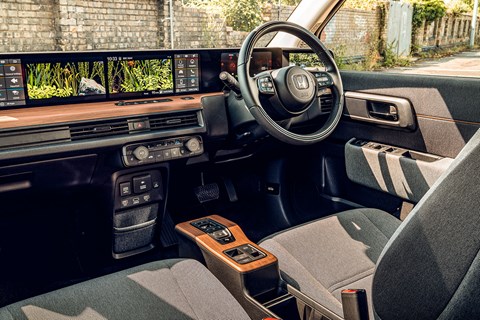
Press the start button (yes, this can be done by phone too) and the screens light up like a Christmas tree and certain pixels grab my attention: the range reads just 94 miles after an overnight charge on a proper wallbox. Blame the modest 35.5kWh battery, whose capacity is 40 per cent smaller than the Peugeot’s 50kWh. There’s simply less energy stored on board; Honda claims only 125 miles on the WLTP cycle. We never saw the range meter tip into three figures, and this poor endurance is the Honda’s Achilles’ heel. As a result it’s surely going to be confined to second-car status; a fun urban runaround for those living in big cities.
The official claims say one thing, but as part of our testing we took all three electric tots on an identical 26-mile journey to see how they fared in real-world driving. It’s no lab test, but we set the climate to 20°C, switched off all ancillaries like seat heaters, selected the most eco driving mode available and stuck to the speed limits. Driven thus, the Honda went from 100 per cent to 79 per cent (but the range dipped just two miles from 94 to 92), which goes to show the vagaries of electricity consumption and the complexity of predicting range. Our prescribed, semi-scientific journey gobbled energy at the rate of a kilowatt hour for 3.5 miles.
So you end up pootling gently everywhere in the Honda, trying not to tap into its instant 232lb ft of torque and instead marvel at how smoothly it drives. It reminds me of my old BMW i3 long-term test car, with a similarly well-damped ride quality, darty steering and an extraordinary 4.3-metre turning circle for taxi-spec manoeuvring around town. It’s comfier than the bumping Mini, more agile than the sensible Peugeot and somehow manages to make you trust the all-digital trio of mirrors right from the off.
Who’d have thunk it? In the E, Honda might just have released its most significant car since the 1989 NSX.

Mini Electric pre-flight briefing: why is it here?
Mini’s hatch continues to woo with cheeky looks, go-kart drive and quality allure; last year it was the eighth best-selling car in the UK. The Electric – available only as a three-door – has arrived this summer to stimulate interest further.
Any clever stuff?
BMW’s led the way with electrification and the Mini’s innards benefit from i project learnings; the motor is nabbed from the i3 S and its brawny 182bhp is nearly 50 ponies up on the least powerful car here, the Peugeot e-208. The Electric’s lithium-ion battery is the smallest of this trio at 32.6kWh, allowing an identical bootspace to combustion Minis (although they don’t have to carry charging cables).
Which version is this?
A simple range structure awaits. Pick 1, 2 or 3 trim level. This one’s a top-spec 3 without a single optional extra – just as well given it’s the priciest car in this test as it is, whether you’re paying outright or leasing with monthly payments.
Our full Mini Electric review
Mini Electric road test
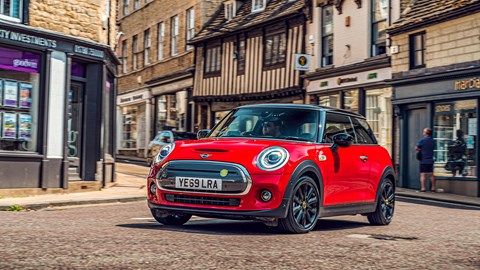
Stepping from the Honda E to the Mini Electric is quite a shock. For two decades we’ve been lapping up the baby BMW’s fun and fizzy character, but the Brit suddenly feels old in this company.
Large dinner-plate-sized circular infotainment screens and a brace of retro toggle switches look quaint next to the digital wizardry of the Honda. You sit low in the sportiest driving position and you’re reminded that the Mini is the shortest, lowest and narrowest car on test. The package is correspondingly snug: you miss the rear doors of the other two and the cramped back seats are a joke, compared with the adult-friendly second-row accommodation in the e-208 and occasional-pub-run status of the E.
None of these cars has a particularly big boot, and space is gobbled up by charging cables and paraphernalia; the Mini’s loadbay will squeeze in a little more shopping than the Honda’s, though neither can live with the Peugeot’s generous 311-litre compartment. Which is what you’d expect if you compare a supermini with two city cars.
There are few telltale signs to the outside world that this is an Electric rather than a petrol-fuelled Mini: ours does without the three-point-plug-inspired alloy wheels, and only subtle badging and the absence of an exhaust pipe give the game away. When you pull away and tickle the throttle the Mini is comfortably the fastest on test, making the most of its 31bhp power advantage over the Honda. All three cars are speedy from standstill to 30mph, but the Mini keeps on reeling in the horizon urgently, even at motorway speeds. Like the Peugeot, its top speed is capped at 93mph (the Honda will brush 100mph if you can smother your range anxiety for long enough).
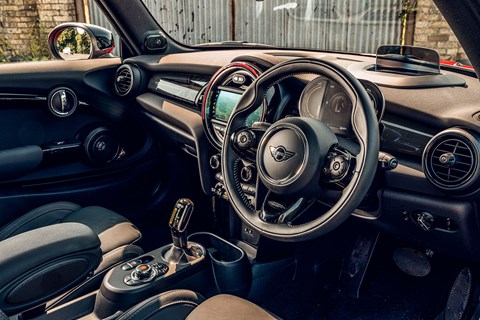
That 7.3sec 0-62mph time makes this a genuine hot hatch, and this is surely the reason you’d pick the Mini – it is the most athletic car here. That familiar heft to the steering, the darty handling, the upright driving position and ease of positioning on the road – the brand traits are all present and correct. What’s less welcome is the dreadful sci-fi whooshing noise on start-up and shutdown, and there’s more artificial whirring when you pootle at low speeds, too. Yes, EVs legally have to emit low-level noises to alert pedestrians, but does it have to be this childish?
Pull out of town and once you’ve got used to the instant hit of performance the Mini can muster, you start to notice other things. Like how the steering writhes and twists in your palms if you prod the accelerator too far; torque steer is a constant companion. The ride quality is also markedly worse than in the beautifully damped Honda or resolutely comfortable Peugeot. It pogos and crashes over those peculiarly rubbish B-roads that British councils specialise in, but things settle down on a motorway or around town. All three rivals wear identical 205/45 17-inch tyres, so it must be down to the suspension set-up. It’s a shame the Electric has lost some of the chassis poise its combustion brothers enjoy, but the Mini is the lightest car here (at 1365kg, it’s nearly two hundred kilos lighter than the Honda!) and can be flung around with reasonable abandon if you want to play hot hatch.
Where the Mini scores highest is the maturity of its electrification. Fully charged, the Mini’s range says 98 miles and after navigating our identical test route that fell to 87 miles with 84 per cent of charge remaining – a useful advantage over the Honda. Most impressive of all was the fact the journey consumed a kilowatt hour every 4.8 miles, the most miserly consumption on test. You’re left with the feeling that Mini has really tapped into the BMW group’s expertise in EVs; all those energy management learnings from the i3 and i8 have paid off in making every single amp, volt and watt matter.
The Mini’s old-worlde charm is at odds with the cutting-edge tech under the skin, and you’re left wondering if this is a brand hamstrung by the weight of its history. Like the dynamic obsession with sportiness that ruins ride quality. Or the insistence on a large circular dashboard display, despite the inefficiency of a rectangular touchscreen within. The Mini’s pop-up head-up display is leapfrogged by the cutting-edge Honda’s widescreen. And isn’t it time that Mini stopped slathering Union Jack branding everywhere? I counted six flags on the seats alone, plus the large engraved dashboard motif and the rear light graphics…
The Mini couldn’t feel more different from the Honda, which is resolutely modern to its core. It feels like the world has moved on.
Mini Electric vs an original Austin Seven: we go back to the future

Peugeot e-208 pre-flight briefing: why is it here?
Available in petrol, diesel and electric forms, the 208 is the 2020 European Car of the Year.
Any clever stuff?
It’s underpinned by the PSA Group’s e-CMP platform, so it’s the same electric hardware you’ll find under the skin of the battery-fed Vauxhall Corsa. Where you’d find the fuel tank and exhaust on a combustion 208, you’ll find lithium-ion battery cells – and they’ve had to develop an angled rear axle that bends around the battery pack but maintains the same wheel position. Just one power output is available for now, 134bhp. The 7.4kW onboard charger takes 7.5 hours to charge up from a domestic wallbox; find a 100kW DC rapid charger and that tumbles to a half-hour wait for 80 per cent capacity.
Which version is this?
GT spec comes with a host of goodies such as fully automated parking assistance. You can spec an e-208 from £25,050 (after the government grant).
Our full Peugeot e-208 review
Peugeot e-208 road test
And so to the Peugeot, perhaps the most understated of this trio. Devoid of retro styling flourishes, the nearest the 208 gets to looking backwards is the C-pillar kink that references the windowline of the much-loved 205, this magazine’s car of the ’80s. Unencumbered by modish influences past or future, it’s a design that works well in the here and now.
The Peugeot is the only car here that busts the four-metre mark on a tape measure and is correspondingly the roomiest inside, with genuine space in the back for adults. Its loadbay is the most capacious, and if you value roominess and practicality it’ll be the easiest car here to slot into your life. Peugeot’s insistence on sticking with its Lilliputian i-Cockpit interior design means those not familiar with the tiny steering wheel/raised instrument layout may be flummoxed, but it’s easy to adapt. One nice touch is the layered, three-dimensional graphics on the digital dials – clever design; a simple trompe l’oeil to give the appearance that some of the readings are floating.
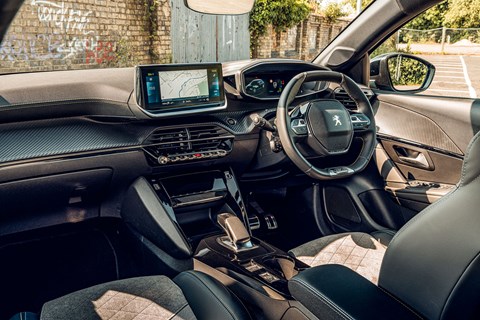
This is an interior that for the most part is simple and effective. Quality of materials and design is surprisingly high for a car from a mainstream French manufacturer, and although it can’t match the expensive polish of the Honda’s space-age cabin, we’d rather spend time in here than in the Mini’s paean to plastic. We aren’t fans of the 208’s faux carbonfibre strip across the dashboard, however, and the shiny piano-black trim on the centre console attracts fingerprints within minutes. The infotainment system is convoluted and slow to respond, lagging behind the simplicity and modernity of the controls in the Honda and Mini.
But what is the Peugeot like as an electric car? Just as the 208’s footprint is a size up from the other two, so is battery capacity. A 50kWh lithium-ion pack is slung under the seats, providing a considerable advantage for range and performance, and this will appeal to users who aren’t intending to keep their EV as a second or third car purely for short shopping trips around town. We struggled to drive the Honda from Peterborough to Cambridge and back on a single charge – and that’s a (largely flat) journey of 41 miles each way. With the Peugeot, such trips are no longer a complication requiring ZapMaps and blagging access to friends’ three-point plugs.
Even when fully charged, though, we never got the Peugeot to anything like its quoted 217-mile range – a flaw that every one of these cars shared (although we tested them in the hottest week of the summer). We’d be cross if we’d bought one and were never able to get close to the advertised distance. After charging the Peugeot overnight, the range settled at 149 miles and that fell to 130 after our standardised 26-mile route. Energy usage stood at 3.9 miles for every kilowatt hour, putting it just ahead of the Honda on consumption but behind the frugal Mini.
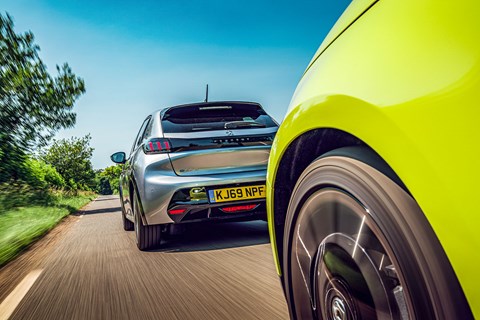
Slip behind the wheel and the Peugeot is a sprightly car to drive. Each car here responds briskly to the accelerator and the e-208’s 0-62mph time of 8.1sec is actually quicker than its 205 GTI 1.6 great grandfather. Steering response from the shrunken wheel is quick and eager, the supermini turning in smartly, and you’re left thinking that the forthcoming performance versions could be quite something. Peugeot execs have already confirmed that future GTIs will be electric and we suspect they’ll take the pocket-rocket sector by stealthy storm.
The e-208 rides with a comfortable pliancy, riding out the bumps and lumps of British blacktop with a smoothness that eludes the Mini if not quite matching the polish of the Honda’s chassis. Although it has the least powerful electric motor, you’ll rarely want for more than 134bhp, and the front axle doesn’t tug and fight like the Mini’s. One black mark against the Peugeot is the strange absence of regenerative engine braking – the e-208 never operates as a one-pedal driver, and you end up dipping into the friction brakes where its rivals let you harvest kinetic energy during deceleration by coasting. No matter how we played with the Normal, Eco and Sport modes and selected B for Braking in the transmission, the e-208 never had more than modest regen. Porsche argues high regen is obtrusive and gimmicky. Seems Peugeot agrees.
It hasn’t stopped Peugeot hitting the bullseye with this electric car. It’s attractively priced and designed, generously packaged and equipped, and above all decent to drive and with the best range here. Could this baby lion cub be the one that’ll tempt sceptics to take the plunge and plug in? On this evidence, it’ll stand a very good chance indeed.
Verdict
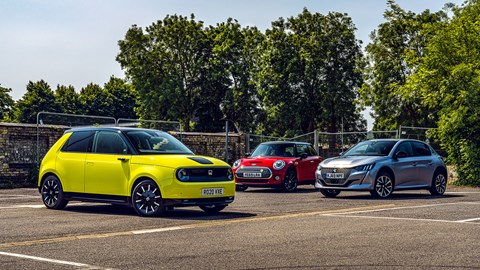
This trio feels zeitgeisty and incredibly on-point for the anxiety-laden, finger-gnawing 2020s: electrically powered to save the polar bears, small enough to thread through our increasingly congested cityscapes, yet boasting enough dynamic fizz to reward keen drivers on occasional extra-urban forays – and with an eye on urban chic to boost kerbside feelgood factor for some catwalk cool. Each one couldn’t be more on trend if it tried.
Mini has been ploughing a similar furrow for two decades under BMW ownership and there are few surprises with the Electric. In the spirit of all the best Minis, however they’re powered, the British contender is damn fast – comfortably the quickest car here – but what surprised us more was how it lacked the sophistication of the others. We never thought we’d say it, but the Mini is beginning to feel its age and the time for cartoon-oversized dials and kitsch detailing might have passed. The new kid on the block from Japan has moved the look-at-me goalposts and the Brit try-hard is no longer quite so compelling, especially with its desperately short range (the Mini’s drivetrain is very efficient but hamstrung by a tiny battery) and the least practical cabin on test.
The Honda E is a breathtaking achievement: one of those rare cars that only comes along once every few years and shakes up the established way of doing things. It’s arguably the coolest car of the summer/year/decade thus far, and the design is winningly successful outside and in.
But there’s real substance behind the E’s flair, and if we were judging this Giant Test on driving qualities alone, it would walk into the sunset with the e-plaudits. It has a sophistication to ride and handling that the others can’t match, the cheapest price tag (whether you pay outright or on the tick) and a depth of engineering to soften the blow that Honda is giving up on VTEC and combustion for a new kind of motive power in the years ahead.
If we lived in central London and never ventured outside the North Circular, the Honda would walk this test – but its tiny range and equally small boot conspire to leave the Peugeot in pole position. The e-208 is a resoundingly successful small car that just happens to be electric – strong in every single area we judged and weak in none. Its regular supermini roots endow it with the most generous packaging for bodies and baggage, it’s good to drive and it won’t run out of slow-to-replenish juice the moment you accidentally turn onto the M25. It’s the best electric hatchback here and, if you can resist the Honda’s undeniable charms, the one we’d suggest you plug into.
The final reckoning

1st Peugeot e-208
The complete small electric car: this compact EV is strong in every area, and weak in none
★★★★
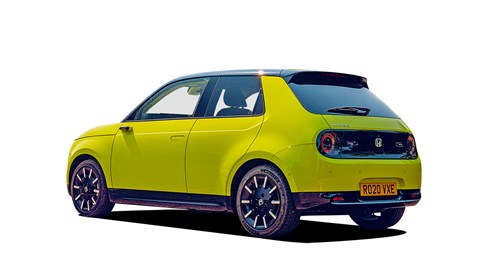
2nd Honda E
One of the coolest cars of 2020: achingly hip and a joy to drive, let down by tiny range and boot
★★★★
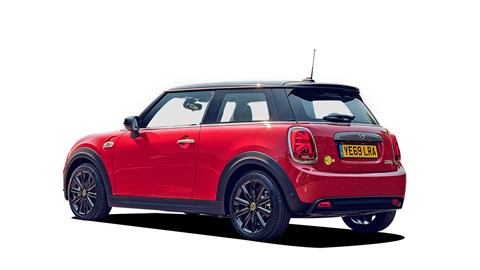
3rd Mini Electric
Firecracker performance can’t make up for ageing foundation, and battery range isn’t great
★★★
Further electric car reading
How much does it cost to charge an electric car?
Wireless charging: the future of topping up your battery
The best electric SUVs